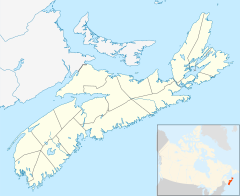| St. Peters Canal | |
|---|---|
 The single lock in the canal features an unusual double-gate system used because each end of the canal (Atlantic Ocean and Bras d'Or Lake) has a different tidal regime. | |
St. Peters Canal in Nova Scotia | |
| Country | Canada |
| Coordinates | 45°39′19.5″N 60°52′6.85″W / 45.655417°N 60.8685694°W |
| Specifications | |
| Maximum boat length | 301 ft 0 in (91.74 m) (Regularly limited to 91.44 metres (300.0 ft)) |
| Maximum boat beam | 47 ft 0 in (14.3 m) |
| Maximum boat draft | 16 feet (4.9 m) |
| Maximum boat air draft | 105 feet (32 m) |
| Locks | 1 |
| Status | Open |
| Navigation authority | Parks Canada |
| History | |
| Construction began | 1854 |
| Date completed | 1869 |
| Geography | |
| Start point | St. Peters Inlet of Bras d'Or Lake |
| End point | St. Peters Bay of the Atlantic Ocean to the south |
The St. Peters Canal is a small shipping canal located in eastern Canada on Cape Breton Island. It crosses an isthmus in the village of St. Peter's, Nova Scotia which connects St. Peters Inlet of Bras d'Or Lake to the north with St. Peters Bay of the Atlantic Ocean to the south.
In the vast majority of canals the flow of water is unidirectional. That is, the "high" side of the canal is always the same. St. Peter's Canal is unusual in that, due to the difference in the timing of the tides between Bras d'Or Lake and the ocean, during part of the tide cycle the Atlantic side is the higher, in other parts of the tide cycle it is the lake side. As a result, the canal requires special "double" gates, the only ones of their kind in North America. The usual canal lock has a gate at each end, each gate consisting of two swinging doors that when closed form a shallow 'V' shape, with the point of the 'V' pointing upstream. At the St. Peter's Canal lock each gate consists of four swinging doors which form a diamond shape when closed. In actual use the pair of doors which form the upstream pointing 'V' are used. No matter which side has the higher water level, either one pair or the other will be appropriate.[1]
Vessels transiting the canal are limited by the size of the lock, which measures 91.44 m (300 ft) long, 14.45 m (47.4 ft) wide, 4.88 m (16 ft) draught and air draught of 32 m (105 ft). A swing bridge over the canal has 6 m (19.69 ft) of clearance when closed and is operated from the bridge house on Grenville Street.
St. Peters Canal is the only working canal of national historic significance in Atlantic Canada and an important historic landmark for the Village of St. Peter's and for Cape Breton Island. St. Peters Canal is part of a nationwide family of over 900 national historic sites, including 9 operating canals.[2]
- ^ "St. Peter's Canal National Historic Site". Retrieved 30 August 2019.
- ^ Cite error: The named reference
St. Peters Canal and St. Peters National Historic Sites of Canada Management Planwas invoked but never defined (see the help page).
